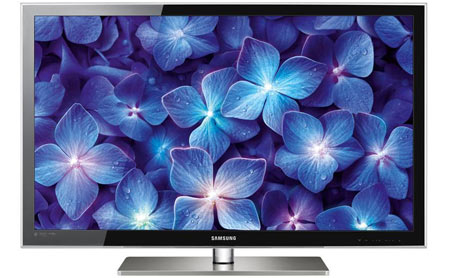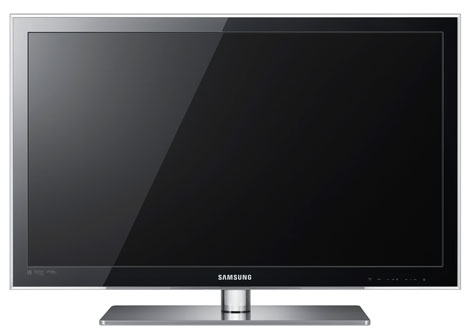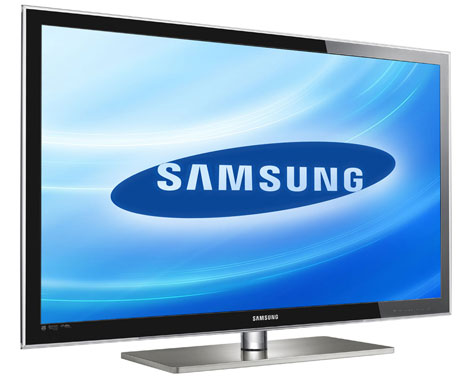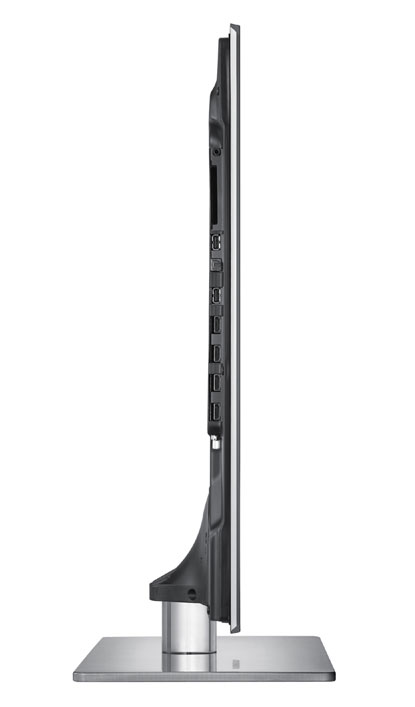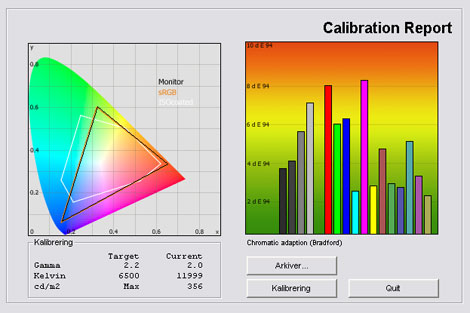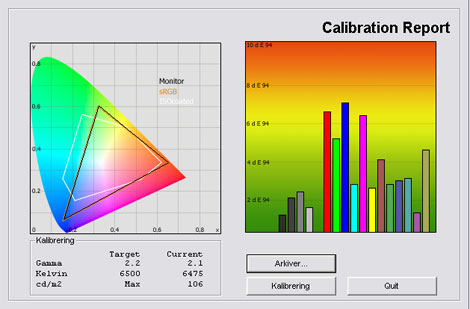Review: Samsung C6000 (C6300)
Samsung C6000 review
C6000 is part of the 2010 line-up from Samsung and one of the lower priced Samsung LED models. Features like the Internet function has been left out but C6000 still has the very slim design, DLNA and 100/120 Hz.
In this review we're taking a look at the 40-inch C6000 that is in stores now. Can the C6000 build on the success from the 2009 Samsung"LED-TVs" (LCD-TV with LED) that was received very well by the market? And what about DLNA that has made it to this model? Read on to see FlatpanelsHD's findings in this Samsung C6000 review.
Samsung C6000 will be available in 32, 37, 40, and 46 inches called 32C6000, 37C6000, 40C6000, and 46C6000. These are the European model numbers. In US the model is called Samsung C6300, C6400 or C6500.
Subscribe to our Newsletter to receive e-mails when new reviews are online. We’ll soon publish our Panasonic V20 and VT20, Samsung C7000 and Sony EX500 reviews as well.
Panel size: 40" widescreen (LCD) Resolution: 1920x1080 Response time: - Contrast ratio: 4.000.000 (dynamic) Brightness: - cd/m2 Color support: 16,7 million colors Signal processing: 8 for each color Viewing angles (H/V): 178/178 Dot pitch: - Panel type: LCD with Edge LED Wall mounting: Swivel stand: Dimensions (HxWxD): 58.5cm x 96.1cm x 3.0cm (without stand) Weight 12.4 kg Built-in speakers: Input formats: 480p/i, 576p/i, 720p, 1080i & 1080p (50, 60 & 24p) Inputs • VGA • DVI (can be converted through HDMI)
• Audio (type) (Audio in/out)
• SCART (1 input)
• S-video • Composite • Component 
• HDMI (4 inputs)
• Andet Udgange • Audio (type) (1 output)
• SCART • S/PDIF (optical)
Tuners • Analog • DVB-T • DVB-T (MPEG4) • DVB-C • DVB-C (MPEG4) • DVB-S • DVB-S (MPEG4) • Other Price and retailer:
| US retailer (40C6300 in the US) | UK retailer |
 |  |
Our first impressions
Samsung C6000 is not much different from the 2009 Samsung"LED-TV" ranges from Samsung. It has a black frame in glossy plastic that is covered with a transparent plastic layer. The transparent layer also extends wider than the black frame and helps create a soft look.The stand has been made from aluminum and has a manual swivel function. It provides a solid foundation for the very lightweight TV.
The C6000 is very slim and with a depth just below 3 cm C6000 is a real"flat panel" TV that is also elegant from the sides. It has no secrets.
Samsung was a pioneer in slim TVs and slim wall-mounting solutions. One of the great things from the 2009 range was that all inputs and outputs very located on the back and pointing to the side or the bottom instead of pointing out towards the wall. Of course this is also the case with C6000.
On C6000 you can also unplug the power cord. This was not possible on the 2009 models.
On the side we also find two USB inputs for connection a Wi-Fi USB dongle, a USB stick or external USB hard disc (for Media Play, not PVR. The PVR function is found on the C6500 ranges and above).
Test tools
Our TV signal is DVB-S (satellite) from Canal Digital and DVB-T (terrestrial). We also have an analogue TV connection. Testing is done with the DVE (digital video essentials) and Peter Finzel test DVD. Testing is also done with DVD, TV, Blu-Ray and Media center/PC.We use our own monitorTest. The software supports some of the traditional test patterns used to evaluate displays as well as some new and unique test patterns developed by the people here on FlatpanelsHD.
Sony PlayStation 3 is our Blu-Ray player.
All contrast measurements are based on the ANSI methodology.
Functionality
Samsung didn't provide the remote that has been lost for this sample. However, C6000 does not feature the new Samsung Premium Remote or the Premium Touch Remote that is a part of the C9000 series.DLNA
DLNA is a part of the TV and this is interesting. On last year's models you had to buy the B7000 to get DLNA and Internet features. This year Samsung has incorporated DLNA in the C6000 range.
The DLNA menus have been changed and received a graphical lift. It looks good and appealing.
C6000 supports video, music and photos. With photos and music you can do stuff like slide shows, repeat, shuffle etc.
The loading time has been reduced a lot compared to the 2009 models and this is very positive. In my opinion the 2009 models had the best Media functions on the market and C6000 improves the DLNA part.
Of course I can't say anything about the Internet function and Samsung Apps because it's not part of the C6000 series but I feel that C6000 is once again proving that Samsung pays attention to the media functionality.
The only time I had to wait was when I tried to access folders with a lot of content. Waiting time was much lower than on both the LG and Sharp TVs that we tested recently.
I found support for most common video codecs but had some trouble playing IMG (video images) and MKV even though C6000 should support these. I played most AVI and mpeg files.
Calibration settings
Samsung C6000 has some interesting setting options in the menus.
Samsung has integrated these calibration setting options: Backlight, contrast, brightness, color, tint, and sharpness. It also has some Eco modes and in the advanced settings I found: Black tone, dynamic contrast, shadow detail, gamma, expert pattern, RGB Only Mode, Color Space, White Balance (RGB), 10p White Balance, Flesh Tone, Edge Enhancement, xvYCC and LED Motion Plus.
Finally, in the picture options menu I found: Color Tone, Size, Digital Noise Filter, MPEG Noise Filter, HDMI Black Level, Film Mode and 100/120 Hz Motion Plus.
The 100/120 Hz Motion Plus also has advanced settings to control the amount of blur reduction compensation and judder reduction compensation. This is quite cool because in the past Samsung's 100/120 Hz circuits had a tendency to be too aggressive.
You can also select from these picture modes: Dynamic, Standard, Natural, and Movie.
Energy consumption
Energy consumption on Samsung 40C6000 has been measured below.| Out-of-Box | After calibration | |
| Standby | 0,0 W | 0,0 W |
| SD | 98,4 W | 72,2 W |
| HD | 98,4 W | 72,2 W |
After calibration I measured average Energy consumption of 72.2 W. This is typical for an Edge LED model and quite low compared to the competitors and especially plasma TVs.
On the 46-inch Samsung B7000 from 2010 we measured 98 W after calibration.
Also, please note that the flat panel TVs uses less power after calibration. This is common on flat panel displays because many picture parameters are reduced during calibration.
Calibration on Samsung C6000
I took a preliminary measurement on Samsung C6000 with the out-of-box settings. Below you can see my result in the Dynamic mode.The graph says this:
The number on the left is the delta value. Delta is a difference between two factors; here it’s the difference between the measured color on the panel and the actual color that is our target.
The dynamic picture mode is not good for home use. It has a very high color temperature meaning that the picture is too bluish and cold, as well as a very bright picture with a brightness of 365 cd/m2.
Gamma also varies from 1.8 in the dark shades to 2.1 in the bright shades. Still, it’s not as bad as on some of the previous Samsung TVs but I still recommend you to use another picture preset.
I changed to the Movie mode and did a calibration. Below I have taken a new measurement.
This was much better and the color temperature is now close to our target of 6500 Kelvin. Brightness was reduced a lot and optimized for dimly lit environments. Gamma is not perfect but close to our 2.2 reference.
Colors still deviate a bit from our target and the Movie mode is not close to the THX mode on Panasonic G20 that gave us very good color accuracy.
Below my picture settings after calibration.
| After calibration | |
| Profile: | Movie |
| Backlight | 7 |
| Contrast | 95 |
| Brightness | 45 |
| Sharpness | 0 |
| Color: | 50 |
| Tint: | G50/R50 |
| Black Tone: | Off |
| Dynamic Contrast | Off |
| Shadow Detail | -2 |
| Gamma | -1 |
| Color Space | Auto |
| Flesh Tone | 0 |
| Edge Enhancement | Off |
| xvYCC | Off |
| LED Motion Plus | Off |
| Color Tone | Warm2 |
| Size | Screen Fit |
| Digital Noise Filter | Off |
| MPEG Noise Filter | Off |
| HDMI Black Level | Low |
| 100/120 Hz Motion Plus | Standard/Off |
| • R-Offset: | 25 |
| • G-Offset: | 24 |
| • B-Offset: | 25 |
| • R-Gain: | 25 |
| • G-Gain: | 23 |
| • B-Gain: | 24 |
I did a RGB calibration and had to lower gamma to -1 in order to get better gamma tracking on C6000. The backlight setting has been calibrated for a dark or dimly lit room so if you plan on using these settings for daytime viewing you should increase the backlight setting.
You should also use the Screen Fit aspect ratio with HD content to get correct scaling and ensure no loss in detail.
Picture quality on Samsung C6000
I'll talk about reflections in the later viewing angles section. As said in the beginning C6000 has no glass front like LG LE8500, Sharp LE820 and Sony NX700.SD reproduction on C6000 is acceptable. De-interlacing is good, scaling is okay but C6000 still lacks some detailing. C6000 does not utilize as powerful picture circuit as some of the more expensive series but I feel that C6000 lacks just a bit - also compared to some of Samsungs more expensive TVs. However, the relatively deep black and fairly natural colors contribute to a better experience.
HD is much better. The HD picture is impressive and I enjoy watching HD content on C6000. I feel that the deep black contributes to depth and shadow detailing was better than with the local dimming LED models. I see some of the noise on darker shades, though.
Color accuracy is fair but C6000 has some issues distinguishing all colors. I saw some issues in color gradients where C6000 had some bands. Also some dark color shades has a tendency to display some noise and minor banding. This is probably because of the internal color processing because I saw no such issues when I hooked C6000 up to a PC. The reproduction of bright colors was good on the other hand. Color fidelity is not as good as on Sharp LE820, however.
On B7000 from 2009 we complained about some heavy trailing, especially on dark shades and we also showed you this in a YouTube video.
I was eager to find out if this was a problem on C6000 as well because it seemed to be a matter of too weak processing instead of an actual panel fault. This was supported by the fact that other brands such as Bang & Olufsen that also used Samsung's Edge LED panel, presented much better motion handling without serious trailing in their BeoVision 10.
So I took the V for Vendetta movie that was a good movie to reveal the trailing on B7000 because of the many dark scenes, and tested C6000.
Luckily C6000 has resolved this problem and I'm very pleased with that. Trailing is reduced a lot. I still see some trailing - as with all plasma and LCD-TVs - but it's not a critical problem as with the B7000 that we told users not to buy because of this trailing problem.
C6000 has some traditional trailing and some Overdrive trailing. The Overdrive circuit is perhaps a bit too aggressive giving us a slightly bluish overdrive trailing but it's not critical and most users won't see this.
Motion is handled well and on par with most LCD-TVs today but we also have to say that LG recently achieved a major improvement in response time because of the scanning backlight system on LE8500. We saw the same improvement on the very expensive Bang & Olufsen BeoVision 7-55 and I think Samsung should consider the scanning backlight system as it really improves response time and motion resolution.
On C6000 Samsung has incorporated setting options the 100/120 Hz circuit and this is a good move by Samsung. Some of the previous Samsung models produced a too unnatural and video-like picture with the 100/120 Hz system but now you have the option to control this yourself and decrease the often too aggressive frame interpolation.
It's difficult to say anything definite about the system because it depends on your controls but I still suggest that you refrain from using the system on the High setting. The Standard setting is also a bit too much for my taste but as said you can reduce the settings from here and I suggest that you do that.
The 100/120 Hz system creates some artifacts but the pseudo-look can be reduced a lot. For Blu-Ray content you should turn it off in order to keep the 1080p24 format that is supported correctly.
Gaming on C6000 is good and the much better response time also makes it more suited for console gaming than the B7000 from 2009. In the default settings it has some input lag but if you make sure to disable 100/120 Hz (or at least reduce the intensity of the system) and make sure you don't activate the film mode, input lag is fair.
Below I have measured black levels and contrast.
| Out-of-Box | After calibration | |
| Black level | 0,09 cd/m2 | 0,05 cd/m2 |
| Brightness | 263 cd/m2 | 104 cd/m2 |
| Contrast ratio | 2922:1 | 2080:1 |
Contrast ratio +/- 100
After calibration I measured black depth to 0.05 cd/m2. This is no real improvement compared to the B7000 from 2009. 0.05 cd/m2 is good though and better than most LCD-TVs without local dimming. 0.05 cd/m2 is also just a bit more than most of Panasonic's plasma TVs.
Shadow detailing is fair. I was able to distinguish most of the grey shades from each other. The PVA panels that Samsung has been developing for some years now still have a problem with loss in color gradation from the front, however.
S-PVA has a drop in the dynamic field when you are sitting right in front of it because of the way the small areas (liquid crystals) in each pixel are arranged. When you move your head away from the center line an increase in the dynamic range occurs so that you suddenly have more shades in the dark regions than you have in front of the screen. This is the big Achilles heel of the S-PVA.
That being said, shadow detailing is fairly good on C6000 but sometimes processing in SD and HD of dark colors results in some noise as mentioned earlier in this section.
Finally I examined C6000 for clouding / backlight bleeding issues. Below you see a picture of the TV in a completely dark room.
Samsung C6000 has some clouding issues that are visible in practice. This is a shame and it was also a common problem with the 2009 LED models. I hope that this is not a common fault on the 2010 models.
PC and Media Center
The TV supports 1:1 pixel mapping. In order to achieve 1:1 pixel mapping you need to select the aspect ratio called “Screen Fit” in the OSD.Viewing angles
Viewing angles are fair but not great. Colors get washed out form angles and some colors get a tint such as for example intense red.Contrast is reduced from angles. I have taken a picture of this below.
Reflections in the panel are not bad. When Samsung C6000 is turned off it has a glossy and reflective front but when the panel is on most reflections are reduced to a minimum.
C6000 doesn't have glass front like Sharp LE820 and LG LE8500. This ensures a lot fewer reflections than those two models.
The panel is not completely reflection free and the glossy bezel has reflections but C6000 has no serious issues in my opinion and is a fair choice in this regards for even brightly lit rooms with sunlight.
Sound quality
Sound quality has been improved a bit over last year's models. It's by no means good but I feel that the speakers have a slightly more complete sound feeling. The deep tones a week but not gone like with most of these very slim TVs. The midtones are fair but nothing more.A positive thing is that voices are clear and this is important for TV watching.
I recommend a separate sound system for movies and music.
Conclusion
Samsung C6000 is pretty much similar to the 2009 models in regards of design, functionality and inputs, besides the new DLNA function that is the best we have seen on a flat panel TV so far. It has support for most formats and the navigation is fast. The speakers in C6000 on the other hand are poor.Picture quality has not been improved much compared to the 2009 line-up. The response time has been improved but color reproduction and black levels are pretty much the same. Black depth was measured to 0.05 cd/m2 which is good for a non LED local-dimming LCD-TV and shadow detailing is convincing, too, but we would have liked to see an improvement, just a minor one.
Summed up, this means fair SD and HD picture quality that is convincing but not overly impressive. Also, I’m a bit nervous about the clouding issues that we saw on our C6000 model.
All in all C6000 pretty much has the same characteristics as the 2009 LED models from Samsung. It’s no breakthrough but Samsung did manage to reduce the heavy trailing from the B7000 model. A good TV without critical flaws but the price is a bit too high.
Subscribe to our Newsletter to receive e-mails when new reviews are online. We’ll soon publish our Panasonic V20 and VT20, Sony EX500, Toshiba RV635 and many more.
Samsung C6000 will be available in 32, 37, 40, and 46 inches called 32C6000, 37C6000, 40C6000, and 46C6000. These are the European model numbers. In US the model is called Samsung C6300, C6400 or C6500.
| Pros | Cons | Target group |
| DLNA and loading time | Clouding | Living room |
| Inputs facing to the side | Viewing angles | Home Cinema |
| Black and shadow detailing | Sound quality | Smaller rooms |
| Response time improved | Price a bit too high |
Price and retailer:
| US retailer (40C6300 in the US) | UK retailer |
 |  |

